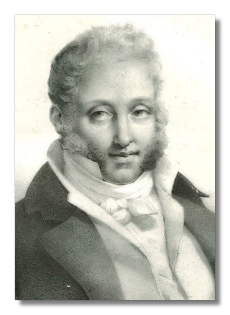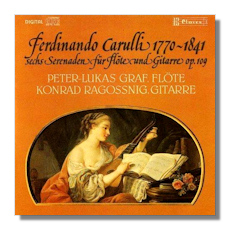
The Internet's Premier Classical Music Source
Related Links
-
Find CDs & Downloads
Amazon - UK - Germany - Canada - France - Japan
ArkivMusic - CD Universe
Find DVDs & Blu-ray
Amazon - UK - Germany - Canada - France - Japan
ArkivMusic-Video Universe
Find Scores & Sheet Music
Sheet Music Plus -
Recommended Links
Site News
Ferdinando Carulli

(1770 - 1841)
Ferdinando Maria Carulli (February 9, 1770 - February 17, 1841) was one of the most influential composers for classical guitar as well as the author of the first complete classical guitar method. He wrote a variety of works for classical guitar, including concertos and chamber works. He was an extremely prolific writer for guitar, writing over 400 works for the instrument in the space of twelve years.
Carulli was born in Naples, Kingdom of Naples on February 9, 1770. His father, Michele, was a distinguished literator, secretary to the delegate of the Neapolitan Jurisdiction. Like many of his contemporaries, he was taught musical theory by a priest, who was also an amateur musician. Carulli's first instrument was the cello, but when he was twenty he discovered the guitar and devoted his life to the study and advancement of the guitar. As there were no professional guitar teachers in Naples at the time, Carulli developed his own style of playing.
Carulli was a gifted performer. His concerts in Naples were so popular that he soon began touring Europe. Around 1801 Carulli married a French woman, Marie-Josephine Boyer, and had a son with her. A few years later Carulli started to compose in Milan, where he contributed to local publications. After a highly successful Paris tour, Carulli moved there. At the time the city was known as the "music-capital" of the world, and he stayed there for the rest of his life.
In Paris Carulli became a very successful musician and teacher. He fulfilled his intention of making the guitar popular and fashionable among the upper classes and Paris musicians. It was also in Paris that he published most of his works, eventually becoming a publisher himself and printing the works of other prominent guitarists.
In the 1830s, many European guitarists followed Carulli to Paris, apparently "attracted by his personality". With so many other guitarists in Paris, Carulli worked harder at his teaching, and soon had counted members of the Parisian nobility among his students.
Many of the pieces now regarded as Carulli's greatest were initially turned down by the publishers as being too hard for the average player, and it is likely that many masterpieces were lost this way. Undeterred, Carulli started publishing his pieces himself. However, the great majority of Carulli's surviving works are those that were considered "safe' enough to be accepted by other publishers, mainly for the teaching of certain techniques or for beginners. Although he had many students and supporters, Carulli began to believe he didn't deserve his impressive reputation because most of the great works he had composed were never published.
Confined to mainly simple pieces, Carulli wrote his world-famous method of classical guitar, "Harmony Applied to the Guitar", a collection of pieces that are still used today in tuition. At the time of publishing, the method was very popular and had many editions published.
Later in life, Carulli began to experiment with changes in guitar construction. With Pierre René Lacôte, a French guitar maker, he made some significant changes for improving the sound of the guitar.
Carulli was among the most prolific composers of his time. He wrote more than four hundred works for the guitar, and countless others for various instrumental combinations, always including the guitar. His most influential work of all was his "Method, Op. 27", published in 1810, and still used widely today in training students of the classical guitar. Carulli also composed some pieces for guitar and piano with his son Gustavo. He wrote works for chamber orchestra and other ensembles.
Aside from his immensely influential Method, published in the early 19th century and still used widely today as a means of teaching students of the classical guitar and helping experts to perfect certain techniques, he changed and improved many aspects of the early instrument to create the modern classical guitar used today.
By the early nineteenth century the guitar had evolved from a lute-like instrument with five pairs of strings to an instrument similar to the guitar we know today, with a flat body, long neck and circular sound hole in the middle. But there were some differences. Carulli's first guitar may have had five rather than six strings, which may have been in pairs (the pairs are known as "courses") similar to the lute and vihuela. The pairing of strings produces a rich, resonant sound when the guitar is strummed but is not so effective for the picking action used in classical guitar, in marked contrast to the similarly strung lute which is usually plucked and seldom strummed. Also, the body of the instrument would have been smaller and less deep, producing a less resonant sound more like that of a violin or ukulele. Finally, the tuning pegs of the guitar were not mechanical but frictional, like those of today's violas and those used on the lute. However mechanical tuning pegs were introduced only about a hundred years ago, well after Carulli's time.
In the later part of his life, Carulli, along with French instrument makers and guitarists Antonio de Torres Jurado and Lacôte, helped to change the guitar into the larger, more resonant instrument we know today. They accomplished this by making the bulges or bouts in the side more pronounced, to produce a greater volume and surface area which made the sound better. Later Jurado also helped to make the modern form of the flamenco guitar which is lighter and smaller with a more brilliant sound than the classical.
Recommended Recordings
Works for Flute & Guitar
- 6 Serenades, Op. 109/Claves CD50-8304
-
Peter-Lukas Graf (flute), Konrad Ragossnig (guitar)
- Concerto in G Major for Flute & Guitar, 2 Duos Op. 104 #1 & 3, Nocturne Op. 190 and Fantasy Op. 337/CBS MK42130
-
Jean-Pierre Rampal (flute), Alexandre Lagoya (guitar), Janos Rolla/Franz Liszt Chamber Orchestra














